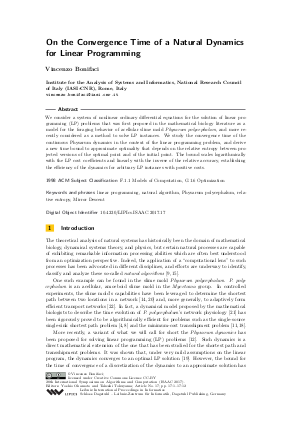On the Convergence Time of a Natural Dynamics for Linear Programming
Author Vincenzo Bonifaci
-
Part of:
Volume:
28th International Symposium on Algorithms and Computation (ISAAC 2017)
Part of: Series: Leibniz International Proceedings in Informatics (LIPIcs)
Part of: Conference: International Symposium on Algorithms and Computation (ISAAC) - License:
 Creative Commons Attribution 3.0 Unported license
Creative Commons Attribution 3.0 Unported license
- Publication Date: 2017-12-07
File

PDF
LIPIcs.ISAAC.2017.17.pdf
- Filesize: 420 kB
- 12 pages
Document Identifiers
Subject Classification
Keywords
- linear programming
- natural algorithm
- Physarum polycephalum
- relative entropy
- Mirror Descent
Metrics
- Access Statistics
-
Total Accesses (updated on a weekly basis)
0Document
0Metadata
Abstract
We consider a system of nonlinear ordinary differential equations for the solution of linear programming (LP) problems that was first proposed in the mathematical biology literature as a model for the foraging behavior of acellular slime mold Physarum polycephalum, and more recently considered as a method to solve LP instances. We study the convergence time of the continuous Physarum dynamics in the context of the linear programming problem, and derive a new time bound to approximate optimality that depends on the relative entropy between projected versions of the optimal point and of the initial point. The bound scales logarithmically with the LP cost coefficients and linearly with the inverse of the relative accuracy, establishing the efficiency of the dynamics for arbitrary LP instances with positive costs.
Cite As Get BibTex
Vincenzo Bonifaci. On the Convergence Time of a Natural Dynamics for Linear Programming. In 28th International Symposium on Algorithms and Computation (ISAAC 2017). Leibniz International Proceedings in Informatics (LIPIcs), Volume 92, pp. 17:1-17:12, Schloss Dagstuhl – Leibniz-Zentrum für Informatik (2017)
https://doi.org/10.4230/LIPIcs.ISAAC.2017.17
BibTex
@InProceedings{bonifaci:LIPIcs.ISAAC.2017.17,
author = {Bonifaci, Vincenzo},
title = {{On the Convergence Time of a Natural Dynamics for Linear Programming}},
booktitle = {28th International Symposium on Algorithms and Computation (ISAAC 2017)},
pages = {17:1--17:12},
series = {Leibniz International Proceedings in Informatics (LIPIcs)},
ISBN = {978-3-95977-054-5},
ISSN = {1868-8969},
year = {2017},
volume = {92},
editor = {Okamoto, Yoshio and Tokuyama, Takeshi},
publisher = {Schloss Dagstuhl -- Leibniz-Zentrum f{\"u}r Informatik},
address = {Dagstuhl, Germany},
URL = {https://drops.dagstuhl.de/entities/document/10.4230/LIPIcs.ISAAC.2017.17},
URN = {urn:nbn:de:0030-drops-82274},
doi = {10.4230/LIPIcs.ISAAC.2017.17},
annote = {Keywords: linear programming, natural algorithm, Physarum polycephalum, relative entropy, Mirror Descent}
}
Author Details
References
-
S. Amari. Information Geometry and Its Applications. Springer, 2016.

-
S. Arora, E. Hazan, and S. Kale. The multiplicative weights update method: a meta-algorithm and applications. Theory of Computing, 8(1):121-164, 2012.

-
D. A. Bayer and J. C. Lagarias. The nonlinear geometry of linear programming, I. Affine and projective scaling trajectories. Trans. of the American Mathematical Society, 314:499-526, 1989.

-
L. Becchetti, V. Bonifaci, M. Dirnberger, A. Karrenbauer, and K. Mehlhorn. Physarum can compute shortest paths: Convergence proofs and complexity bounds. In Proc. of the 40th Int. Colloquium on Automata, Languages and Programming, volume 7966 of Lecture Notes in Computer Science, pages 472-483. Springer, 2013.

-
A. Beck and M. Teboulle. Mirror descent and nonlinear projected subgradient methods for convex optimization. Oper. Res. Lett., 31(3):167-175, 2003.

-
B. Bollobás. Modern Graph Theory. Springer, New York, 1998.

-
V. Bonifaci. Physarum can compute shortest paths: A short proof. Inf. Process. Lett., 113(1-2):4-7, 2013.

-
V. Bonifaci, K. Mehlhorn, and G. Varma. Physarum can compute shortest paths. In Proc. of the 23rd ACM-SIAM Symposium on Discrete Algorithms, pages 233-240. SIAM, 2012.

-
B. Chazelle. Natural algorithms and influence systems. Communications of the ACM, 55(12):101-110, 2012.

-
J. Hofbauer and K. Sigmund. Evolutionary Games and Population Dynamics. Cambridge University Press, 1998.

-
K. Ito, A. Johansson, T. Nakagaki, and A. Tero. Convergence properties for the Physarum solver. arXiv:1101.5249v1, Jan 2011.

-
A. Johannson and J. Y. Zou. A slime mold solver for linear programming problems. In How the World Computes - Turing Centenary Conference and 8th Conference on Computability in Europe, pages 344-354. Springer, 2012.

-
N. K. Karmarkar. Riemannian geometry underlying interior-point methods for linear programming. In J. C. Lagarias and M. J. Todd, editors, Mathematical Developments Arising from Linear Programming, volume 114 of Contemporary Mathematics, pages 51-75. American Mathematical Society, 1990.

-
T. Nakagaki, H. Yamada, and Á. Tóth. Maze-solving by an amoeboid organism. Nature, 407:470, 2000.

-
S. Navlakha and Z. Bar-Joseph. Algorithms in nature: the convergence of systems biology and computational thinking. Molecular Systems Biology, 7:546, 2011.

-
A. S. Nemirovski and D. B. Yudin. Problem Complexity and Method Efficiency in Optimization. John Wiley, 1983.

-
G. Raskutti and S. Mukherjee. The information geometry of mirror descent. IEEE Trans. Information Theory, 61(3):1451-1457, 2015.

-
D. Straszak and N. K. Vishnoi. Natural algorithms for flow problems. In Proc. of the 27th ACM-SIAM Symposium on Discrete Algorithms, pages 1868-1883. SIAM, 2016.

-
D. Straszak and N. K. Vishnoi. On a natural dynamics for linear programming. In Proc. of the 2016 ACM Conf. on Innovations in Theoretical Computer Science, page 291. ACM, 2016.

-
A. Tero, R. Kobayashi, and T. Nakagaki. Physarum solver: A biologically inspired method of road-network navigation. Physica A, 363:115-119, 2006.

-
A. Tero, R. Kobayashi, and T. Nakagaki. A mathematical model for adaptive transport network in path finding by true slime mold. Journal of Theoretical Biology, 244:553-564, 2007.

-
A. Tero, S. Takagi, T. Saigusa, K. Ito, D. P. Bebber, M. D. Fricker, K. Yumiki, R. Kobayashi, and T. Nakagaki. Rules for biologically inspired adaptive network design. Science, 327:439-442, 2010.

